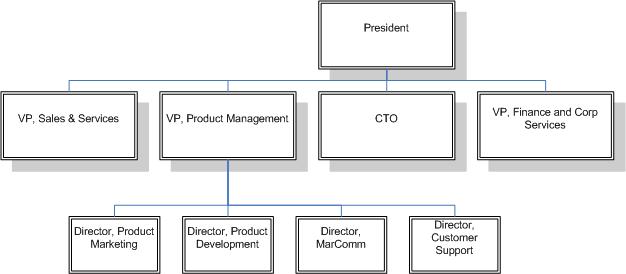Is your Organization Chart getting in the way of creating great products that delight your customers? Is it getting in the way of capturing more marketshare? Let’s face it, the basic structure of org charts has not changed. There’s the President along with Vice Presidents heading up the Finance, Marketing, R&D and Sales departments. But why are many companies so dysfunctional when it comes to defining, building and delivering products? Maybe it’s the structure of the organization. We’ve seen it / lived it over and over – marketing and R&D sometimes just do not play nicely together. Fiefdoms, egos, mistrust – whatever the reason, it can be a real toxic atmosphere. And when times are tough (as they are now) the departments hunker down protecting their turf. And Product Managers who straddle both sides bear the brunt of all this as they try to get products and releases out the door. It’s no wonder that defining, building and delivering products and releases can be sometimes so hard. But it doesn’t have to be.
If you are in a product-driven company – i.e. the business model for generating revenue is by defining, building and selling products – or transitioning into a product-driven company, then this blog post is for you. If you are a services-driven company and have no intentions of becoming a product-driven company, then maybe this post is not for you.
Generally speaking there are 3 major buckets of activities within a product-driven company. Finance and Corporate Services look after the internal workings of the company – making sure that everything is in place and operating properly (including adhering to GAAP so that the president stays out of jail, but I digress). Next is Sales and Services (if Services is a component of your product offering) who are responsible for extracting as much money out of new and existing customers as possible; whether it is direct, indirect, online, telesales, etc. And last (but not least) are the activities around finding markets, defining and building solutions to address market needs and supporting customers. The latter certainly sounds like Product Management. So why do we split this between Marketing and R&D? Why do we have separate fiefdoms to support this essential set of activities? Isn’t managing the product portfolio one of the most important activities in a product-driven company?
So we need to view the org chart from that perspective. I propose an org chart that views the activities of defining, building and delivering products as paramount.
As you can see I propose keeping the VP Finance and Corporate Services and VP Sales and Services roles intact. However the Marketing and R&D roles become the VP Product Management role. This group is chartered with finding markets and their problems, defining solutions to address those problems, building the product, launching the product, communicating its goodness and supporting the customer base. As you can see everything related to the product is in one group. You’ll notice that product development reports into Product Management and that the Technical Product Manager role is absent – it’s part of Product Development. Lastly we have the CTO role. This role is about future technology – embracing new technologies, searching for / inventing technology that will improve the product in the future.
The biggest benefit? The management of the product portfolio, which is the lifeline of a product-driven company, is now the priority … not marketing it, not building it.
